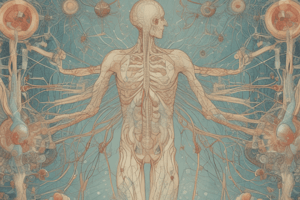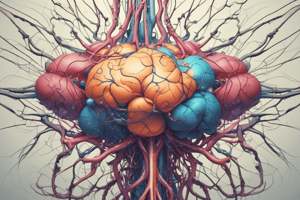Podcast
Questions and Answers
What type of drugs are cholinomimetics classified as based on their mode of action?
What type of drugs are cholinomimetics classified as based on their mode of action?
- Direct or indirect acting (correct)
- Reversible or irreversible
- Agonists or antagonists
- Lipid-soluble or water-soluble
Which characteristic is true for Edrophonium?
Which characteristic is true for Edrophonium?
- It is orally active.
- Its duration of action is 5-15 minutes. (correct)
- It exclusively targets nicotinic receptors.
- It has high lipid solubility.
What is a key feature of Neostigmine?
What is a key feature of Neostigmine?
- It has high lipid solubility.
- It is a quaternary amine. (correct)
- Its action lasts longer than 30 minutes.
- It is not orally active.
Which statement accurately reflects the pharmacokinetic properties of cholinomimetics?
Which statement accurately reflects the pharmacokinetic properties of cholinomimetics?
What is the main action of cholinesterase-inhibiting drugs?
What is the main action of cholinesterase-inhibiting drugs?
What is a cardiovascular effect of nicotine toxicity?
What is a cardiovascular effect of nicotine toxicity?
Which type of mushroom is associated with severe poisoning that includes renal and hepatic necrosis?
Which type of mushroom is associated with severe poisoning that includes renal and hepatic necrosis?
Which of the following is NOT a symptom of muscarine or related alkaloid poisoning?
Which of the following is NOT a symptom of muscarine or related alkaloid poisoning?
What is a major consequence of nicotine toxicity on the CNS?
What is a major consequence of nicotine toxicity on the CNS?
What is a significant toxicological effect linked to the ingestion of certain mushrooms?
What is a significant toxicological effect linked to the ingestion of certain mushrooms?
What is the primary effect of muscarinic blocking drugs on the CNS?
What is the primary effect of muscarinic blocking drugs on the CNS?
What is the mechanism of action for inverse agonists?
What is the mechanism of action for inverse agonists?
Which of the following is NOT a recognized effect of muscarinic blocking drugs on the CNS?
Which of the following is NOT a recognized effect of muscarinic blocking drugs on the CNS?
How do competitive antagonists function in relation to agonists?
How do competitive antagonists function in relation to agonists?
What specific action do muscarinic blocking drugs have on the bronchi?
What specific action do muscarinic blocking drugs have on the bronchi?
Which subtype of muscarinic receptors is primarily associated with cycloplegia?
Which subtype of muscarinic receptors is primarily associated with cycloplegia?
Which effect is associated with the anticholinergic action of muscarinic blocking drugs aside from CNS effects?
Which effect is associated with the anticholinergic action of muscarinic blocking drugs aside from CNS effects?
Which effect occurs due to the blockade of muscarinic receptors in the eye?
Which effect occurs due to the blockade of muscarinic receptors in the eye?
What effect does the presence of a quaternary amine group have on a substance's properties?
What effect does the presence of a quaternary amine group have on a substance's properties?
What is the primary characteristic of atropine?
What is the primary characteristic of atropine?
What effect does atropine have on salivation?
What effect does atropine have on salivation?
Which route of administration allows atropine to have topical activity?
Which route of administration allows atropine to have topical activity?
What is the duration of action for atropine with normal doses?
What is the duration of action for atropine with normal doses?
What type of drug are cholinesterase regenerators classified as?
What type of drug are cholinesterase regenerators classified as?
What is a common source of atropine?
What is a common source of atropine?
How is atropine primarily metabolized in the body?
How is atropine primarily metabolized in the body?
What is the primary ion that contributes to depolarization in the activation of sodium-selective channel proteins?
What is the primary ion that contributes to depolarization in the activation of sodium-selective channel proteins?
Which factor is primarily responsible for the process of vasodilation?
Which factor is primarily responsible for the process of vasodilation?
Which type of receptors are nicotinic receptors on sympathetic and parasympathetic ganglion neurons?
Which type of receptors are nicotinic receptors on sympathetic and parasympathetic ganglion neurons?
What triggers an excitatory postsynaptic potential (EPSP) in the context of sodium channel activation?
What triggers an excitatory postsynaptic potential (EPSP) in the context of sodium channel activation?
Which receptors mediate the release of endothelium-derived relaxing factor (EDRF)?
Which receptors mediate the release of endothelium-derived relaxing factor (EDRF)?
How does depolarization due to sodium influx influence surrounding membranes?
How does depolarization due to sodium influx influence surrounding membranes?
What effect does decreased blood pressure have on the autonomic nervous system?
What effect does decreased blood pressure have on the autonomic nervous system?
Which type of nicotinic receptors differs slightly from NN receptors and is located at neuromuscular end plates?
Which type of nicotinic receptors differs slightly from NN receptors and is located at neuromuscular end plates?
Flashcards are hidden until you start studying
Study Notes
Muscarinic Blocking Drugs
- Quaternary amine groups limit penetration through the blood-brain barrier to reduce CNS side effects.
- Inverse agonists counteract the effects of endogenous agonists, displaying opposite activity.
- Competitive antagonists prevent agonist binding without intrinsic activity.
Effects of Muscarinic Blocking Drugs
- CNS Effects: Sedation, anti-motion sickness, antiparkinson action, amnesia, delirium.
- Eye Effects: Cycloplegia (paralysis of the ciliary muscle), mydriasis (dilation of pupils) via M3 receptor blockage.
- Bronchial Effects: Bronchodilation achieved through muscarinic blockade.
- Urination: Miosis (constriction) can be inhibited leading to urinary retention.
- Miscellaneous: Bradycardia, lacrimation, salivation, and sweating can also be inhibited.
Atropine
- Prototype non-selective muscarinic blocker with a tertiary amine structure allowing lipid solubility.
- Readily crosses membrane barriers; well-distributed in the CNS, eye, and other organs.
- Source from Atropa belladonna and related plants; half-life of approximately 2 hours.
- Duration of action: 4–8 hours for normal doses; prolonged in ocular applications.
Cholinomimetics
- Drugs mimicking acetylcholine actions divided into two major subgroups: direct and indirect.
- Direct-Acting: Bind to acetylcholine receptors affecting either muscarinic or nicotinic cholinoceptors.
- Indirect-Acting: Include cholinesterase inhibitors, enhancing acetylcholine availability at synapses.
Effects of Cholinomimetics
- Increased secretion from sweat glands, gastrointestinal tract, airways, and lacrimal glands.
- Cardiovascular effects include transient bradycardia potentially followed by reflex tachycardia upon IV administration.
- Vasodilation occurs through endothelium-derived relaxing factors (EDRF), primarily nitric oxide.
Nicotinic Toxicity and Mushroom Poisoning
- Ganglionic Stimulation: Results in effects such as fasciculations and paralysis due to neuromuscular end plate depolarization.
- CNS Toxicity: Ingestion of muscarine from certain mushrooms (Inocybe, Amanita muscaria) leads to vomiting and diarrhea.
- Amanita phalloides can cause severe poisoning with symptoms escalating to hepatic and renal necrosis due to toxins.
Cholinesterase Regenerators
- Function as chemical antagonists to organophosphate acetylcholinesterase inhibitors, restoring normal acetylcholine breakdown.
Key Pharmacokinetic Characteristics
- Edrophonium: Not orally active, with a duration of action of 5-15 minutes.
- Neostigmine: Orally active, with poor lipid solubility, treating myasthenia gravis and other conditions.
Summary of Effects
- Activation of cholinergic pathways can result in increased secretory activity and cardiovascular changes.
- Understanding the specific effects and pharmacokinetics is crucial for effective clinical application of these drugs.
Studying That Suits You
Use AI to generate personalized quizzes and flashcards to suit your learning preferences.



